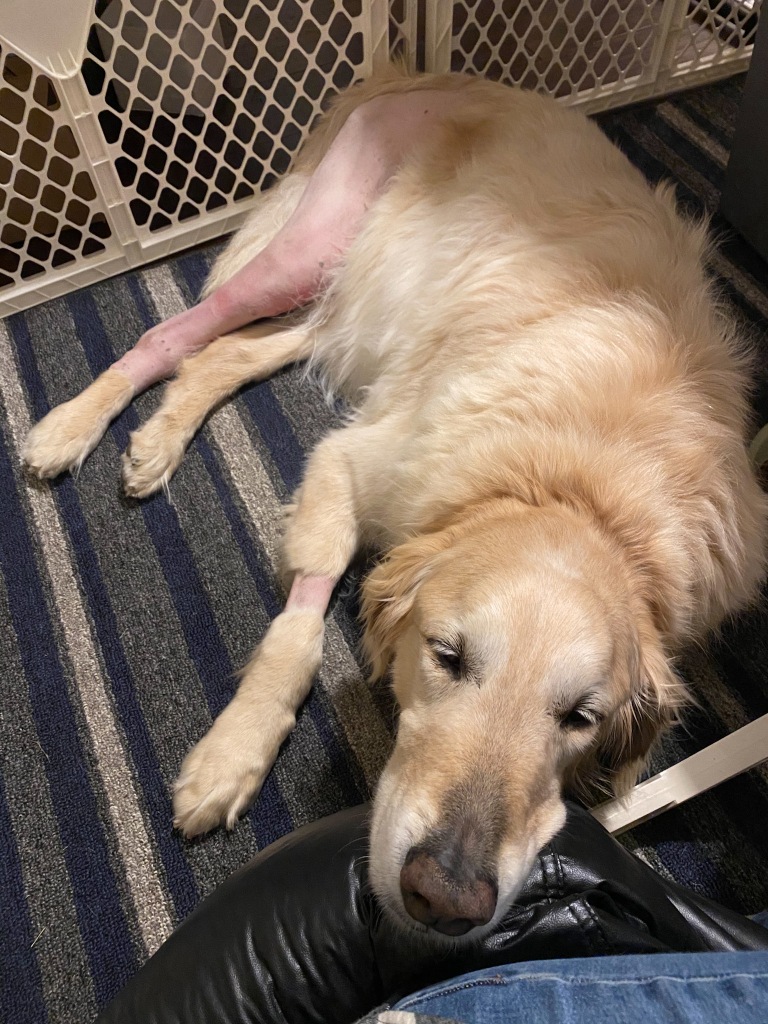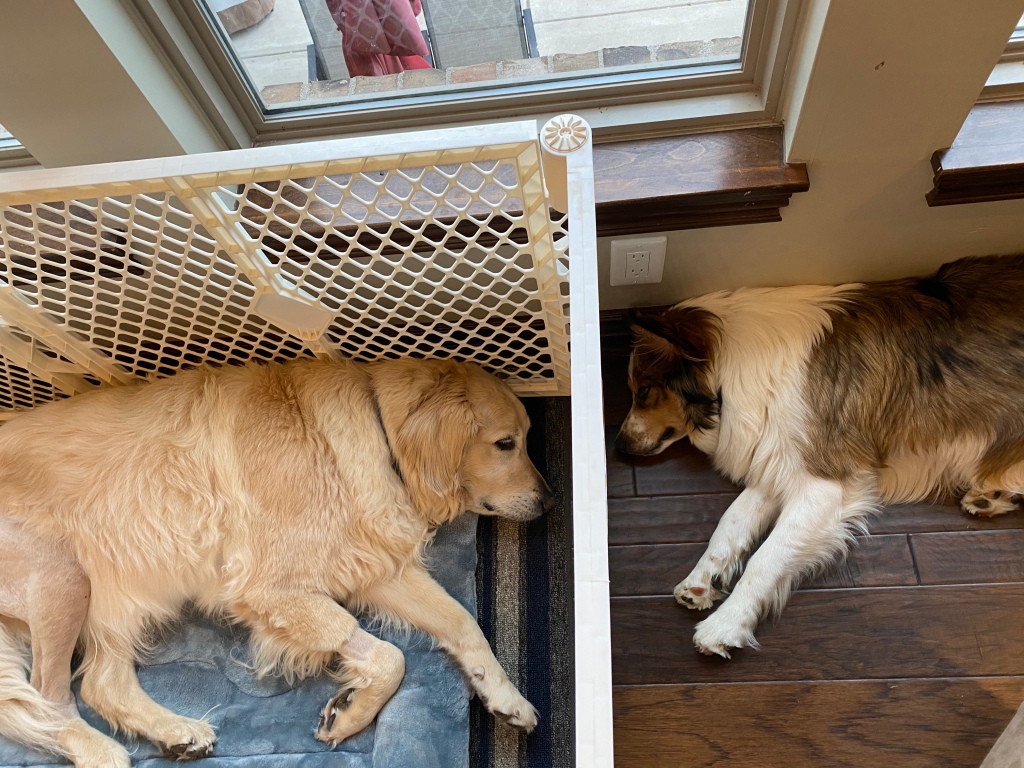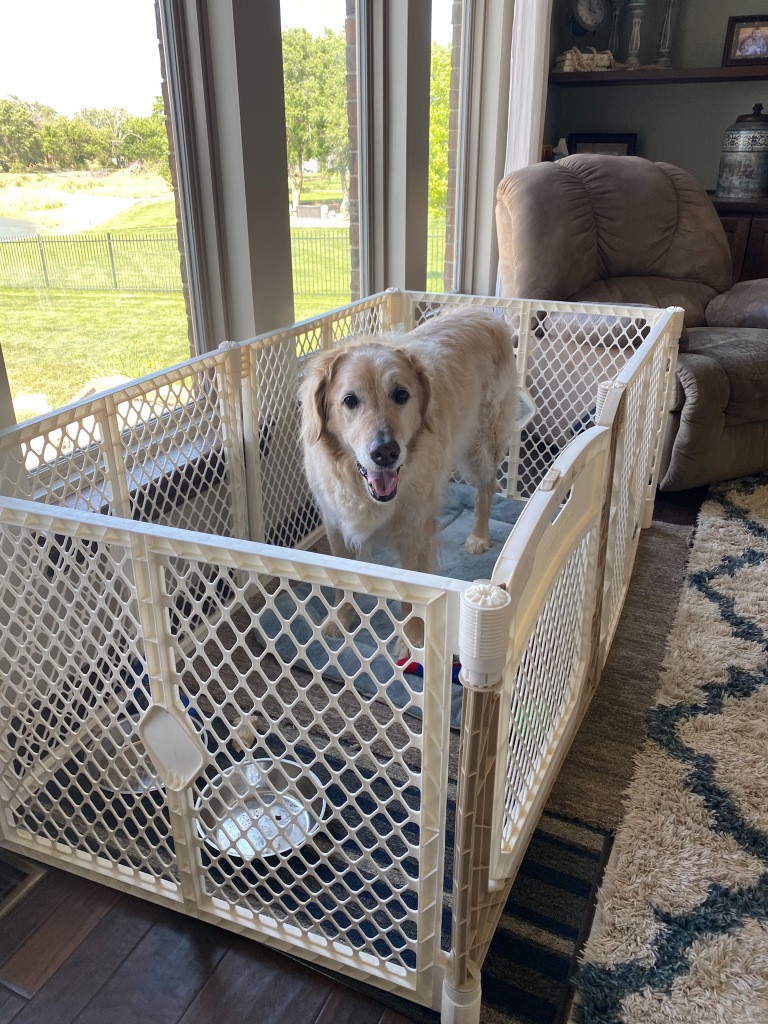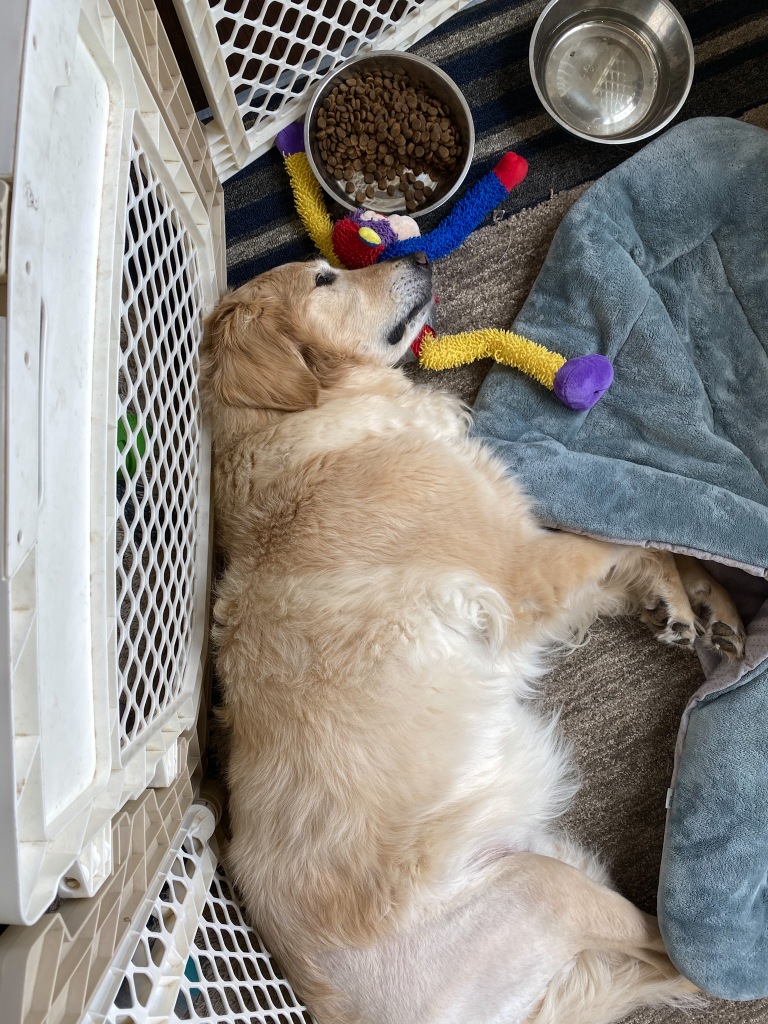Five Things I Wish I Knew Before My Dog’s Surgery and Recovery Supplies You’ll Need
Our 100 lb Golden Retriever needed TPLO surgery to repair his torn CCL (the same as the ACL in humans) in his knee. He’s 10 years old, and thankfully, he’s back to running free all over our yard after 10 weeks of recovery!
*Note: I am not a veterinarian or medical professional. All suggestions are from my own personal experience and are NOT medical advice. Please consult with your vet for any medical advice or recommendations for post-surgery care.
For large dogs, you will probably need TPLO surgery, which is only offered at some vet clinics. Be sure to ask about the post op therapy options…some vets offer it and some don’t. Plan to go back to the clinic where surgery took place for all the post op visits (and there are lots of those), so a clinic near home is much more convenient than one hours away, if you have the surgery option available nearby! If you have the finances and ability to do therapy as your dog recovers, I’d say that’s your best bet. Therapy can help your dog not lose as much muscle mass during the recovery time, which is very important…especially for senior dogs. Therapy our vet provides includes things like laser therapy and water treadmill exercise.
The first two weeks are awful. You will regret ever doing the surgery (they basically cut the leg bone, shift the angle slightly, and reattach it with a bracket & screws, so it’s a lot). But with how successful the recovery is, it was worth it. I slept beside Toby on the floor or couch for the first three days, just to make sure he didn’t get up in the middle of the night and hurt himself.

- Mentally prepare yourself for the first few weeks to be tough. I’d say it’s comparable to the first few weeks of caring for you first baby…lots of guessing, lots of wondering what they need, lots of care needed, lots of worrying about them.
2. Have another adult available to help with taking them out to the bathroom the first few days. My husband held the sling while I walked ahead with the leash and opened up the doors/gates to get to the potty area outside. If you have a big dog, you’ll probably want two people to help get him in the car for vet visits, and to sit with him in the car to make sure he doesn’t stand and stumble around while you’re driving.
Our dog Toby has an iron bladder (he can easily go 7am-3pm without an accident), but I set timers on my phone to take him out to go to the bathroom every 5-6 hours during the day. After a week or two, you’ll start to recognize signs that they need to be taken out. If you can, start letting them out to go to the bathroom at the SAME TIMES every day before surgery, so their body is used to going to the bathroom regularly.
3. Have your dog start going to the bathroom in the location you want them to go post-surgery for a week or two BEFORE the surgery. We didn’t do this, and Toby would NOT go to the bathroom in the front yard near the front steps. He did not pee or poop for 3 DAYS (talk about stressful for ALL of us!), until we finally tried taking him to the backyard where he usually goes to the bathroom. We ended up walking him around the house every time he had to go to the bathroom in the backyard for the next 10 weeks because he won’t go anywhere but there.
4. Make a ramp to go down any stairs he will use to go outside. We made a plywood ramp down our front steps, and it was much better than trying to navigate steps. We used it all 10 weeks of recovery. Make sure it’s not a slippery surface, and not too steep.

5. Get these things. Borrow or buy them, but they are absolutely a life saver while the dog is recovering.
- Sling (practice using it BEFORE surgery…it takes some practice to figure out how to support your dog with the sling and manage the leash at the same time. It also takes time to get the dog used to feeling it on their stomach when they are going to the bathroom!): Your dog will likely pee on it while going to the bathroom (you have a to time it just right and slip it up on their stomach right before they start to pee), so we wrapped it with a puppy pee pad and swapped the pad out when it got wet. That was much easier than washing it every time they go to the bathroom. You could use a towel around their waist to support them (our vet suggested this for a low-cost option), but the ease of using the sling made buying it worth every penny! We used it daily for the first 6 or so weeks, and also to support Toby when we could start taking our dog for walks.
- Baby play yard: We made a pen using 6 of the pieces to make a recovery area in our living room. Get one that has a gate opening.

- Multiple ice packs to place on his knee/leg. Wrap them in a damp towel before putting them on his leg. It makes it cold, but not too cold. The vet will give you instructions on how long/often to ice the leg.
- Two cheap rugs to go under the play yard. This area gets furry, wet, stinky, so it’s nice to have a couple rugs to alternate. We have wood floors, so we put a puppy pee pad UNDER the rug to catch any water drips from the water bowl.
- Comfy dog cone. This gave me peace of mind at night when I couldn’t keep an eye on Toby to make sure he wasn’t licking his leg. We used it for about 1-2 weeks.
- Soft dog bed. This is nice because it’s machine washable. It gave Toby a soft place to lay, since he had to spend all his time there for 8-10 weeks.

- Dog pee pads. The pain meds can make some dogs have an upset stomach (Toby didn’t, but a friend’s golden did after the same surgery). We used them a lot (although we cut them into smaller sections, so only needed one package) for the sling & under the carpet to protect it from water bowl spills/drips, not really for actually catching accidents.
- A new dog toy or two to help with boredom. Eight-ten weeks is a LONG recovery time…even for an old dog like Toby!
- We put a sign on our door that told people not to knock or ring the bell (they texted us if they were friends visiting), just to keep our dog as calm as possible. No need for the dog to go nuts each time someone delivers a package.
- If you have wood floors, get rugs to make a path from the dog pen area to the door to go outside. You don’t want them slipping on the floors as they are walking. We still are using the rugs, even though our dog has recovered, since his leg muscles are still weak after not using it for so many weeks.
I think that’s everything I wish I knew BEFORE we had the surgery so we could be better prepared. Honestly, it’s something I hope we never go through again, but it’s also good to know that the recovery from the surgery was very successful and Toby can now enjoy running around, playing with the kids and his “dog brother” pain free!
This post may contain affiliate links. I paid for all these products myself, and 100% of the opinions shared are my own. There is no extra cost to you, but using the links gives a very small percentage of the sale back to me, and helps me continue to create helpful ideas to share with you!